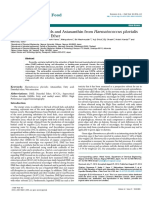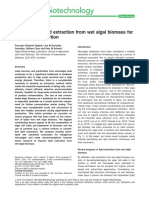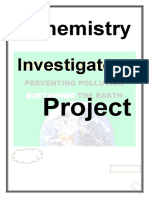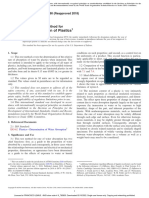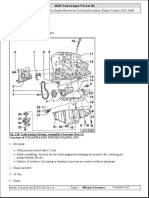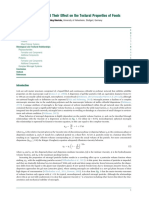Process Optimization of Lipid Extraction From Microalgae Aphanothece
Process Optimization of Lipid Extraction From Microalgae Aphanothece
Uploaded by
ajithjkingsCopyright:
Available Formats
Process Optimization of Lipid Extraction From Microalgae Aphanothece
Process Optimization of Lipid Extraction From Microalgae Aphanothece
Uploaded by
ajithjkingsOriginal Description:
Original Title
Copyright
Available Formats
Share this document
Did you find this document useful?
Is this content inappropriate?
Copyright:
Available Formats
Process Optimization of Lipid Extraction From Microalgae Aphanothece
Process Optimization of Lipid Extraction From Microalgae Aphanothece
Uploaded by
ajithjkingsCopyright:
Available Formats
BioEnergy Research
https://doi.org/10.1007/s12155-022-10464-8
Process Optimization of Lipid Extraction from Microalgae Aphanothece
halophytica in Wet and Dry Conditions
L. R. Monisha Miriam1 · Ajith J. Kings2 · R. Edwin Raj3 · K. Prakash Shyam4 · M. Adhi Viswanathan5
Received: 20 October 2021 / Accepted: 26 April 2022
© The Author(s), under exclusive licence to Springer Science+Business Media, LLC, part of Springer Nature 2022
Abstract
Unearthing new sustainable and economically viable sources for biofuel production which do not affect the environment is
a dire need of the hour. Microalgae is one such promising source due to its high lipid content, productivity, and carbon neu-
trality. Identification of appropriate strain and process optimization decides the biomass productivity, nutrient value, and oil
content which are the major factors for commercialization. In the present work, mass cultivation of halophilic Aphanothece
halophytica in raceway ponds was optimized by using organic and inorganic nutrients by using design of experiments.
Organic flocculant, neem plus was successfully adapted for harvesting the biomass and oil extraction was done with solvent
methodology. A maximum lipid yield of 29.3% was obtained on wet basis, when the reaction temperature, reaction time,
biomass-to-solvent ratio and mixing intensity were kept at 68 ºC, 190 min, 9:1, and 300 rpm respectively. Similarly, on dry
basis, a lipid yield of 27.5% was reported when the reaction temperature, reaction time, biomass-to-solvent ratio and mix-
ing intensity were maintained at 68 ºC, 190 min, 12:1, and 300 rpm respectively. GC–MS analysis of the lipid was done to
appropriate the combination of fatty acid for enhancing the biofuel production.
Keywords Microalgae · Optimization · Oil extraction · Dry basis · Wet basis
Introduction bodies. Additionally, they do not compete with food feed-
stocks [1]. Despite many advantages, there are challenges
Increasing fuel cost, depleting crude oil reserves, and envi- in utilizing them as a fuel source. Energy reduction and
ronmental degradation associated with conventional fuels recovery are the necessary footsteps to enhance the sustain-
urge the researchers to search for an alternative, clean, ability and improve the economic competitiveness. Releas-
renewable, and sustainable biofuel. Microalgae are one of ing the lipids from the microalgal cell wall is a major and
the promising alternatives to conventional fuel owing to tricky step in the extraction process [2]. Usually, for lipid
its high lipid content and productivity. Microalgae has a extraction, microalgal biomass was subjected to mechanical
very fast growth rate and can be cultivated in unused water pressing and organic solvents. In mechanical pressing, the
yield of oil depends on the extraction technique employed
such as screw / piston press, extruder and expander, and pul-
* Ajith J. Kings
ajith@sxcce.edu.in verization using mortar [3]. The organic solvent extraction
employs ‘like dissolving like’ concept of basic chemistry to
1
Department of Biotechnology, Udaya School of Engineering, extract lipid from microalgae using solvents [4].
Vellamodi 629204, India In the cell membrane of microalgae, neutral lipids are
2
Department of Mechanical Engineering, St. Xavier’s Catholic found as a complex with polar lipids and are strongly linked
College of Engineering, Nagercoil 629003, India with the proteins through hydrogen bonds. Ideal solvent
3
Department of Mechanical Engineering, National Rail must be highly specific and volatile in order to ensure low
and Transportation Institute, NAIR Campus, Lalbaug, energy distillation for extracting lipid from the solvent [5].
Vadodara 390 004, India
The polar solvents used are methanol, ethanol, acetone,
4
Research and Development Division, VVD and Sons Private ethyl acetate, and 2-propanol. Similarly, the non-polar sol-
Limited, Thoothukudi 628003, India
vents used for lipid extraction from microalgae biomass
5
Pinnacle Biosciences, Algae Research and Development include hexane, benzene, toluene, diethylether, chloroform,
Center, South Thamaraikulam 629708, India
13
Vol.:(0123456789)
You might also like
- Renewable Energy: Sciverse SciencedirectDocument7 pagesRenewable Energy: Sciverse Sciencedirectilidio costaNo ratings yet
- xue2018Document11 pagesxue2018kaiompsNo ratings yet
- Extraction of Oil From Algae For Biodiesel ProductDocument8 pagesExtraction of Oil From Algae For Biodiesel ProductAbdisa GemechuNo ratings yet
- 1-s2.0-S2211926424000171-mainDocument25 pages1-s2.0-S2211926424000171-mainkaiompsNo ratings yet
- Critical Analysis of Current Microalgae Dewatering TechniquesDocument12 pagesCritical Analysis of Current Microalgae Dewatering TechniquesAna Molero de LopezNo ratings yet
- Enhanced Lipid Extraction From Microalgae in Biodiesel ProductionDocument8 pagesEnhanced Lipid Extraction From Microalgae in Biodiesel ProductionHendra Bayu KurniawanNo ratings yet
- Algal Research: Review ArticleDocument19 pagesAlgal Research: Review ArticleXuan NguyenNo ratings yet
- Wet Extraction of Lipids and Astaxanthin From Haematococcus Pluvialis by Liquefied Dimethyl Ether 2155 9600.1000305Document4 pagesWet Extraction of Lipids and Astaxanthin From Haematococcus Pluvialis by Liquefied Dimethyl Ether 2155 9600.1000305mohsen fatemiNo ratings yet
- Proposal First DraftDocument31 pagesProposal First DraftKeziah AvenidoNo ratings yet
- Cell Disruption Using AcidsDocument17 pagesCell Disruption Using AcidsrinjaniNo ratings yet
- Wet Extraction of Lipids and Astaxanthin From Haematococcus Pluvialis by Liquefied Dimethyl Ether 2155 9600.1000305Document4 pagesWet Extraction of Lipids and Astaxanthin From Haematococcus Pluvialis by Liquefied Dimethyl Ether 2155 9600.1000305Chema RodríguezNo ratings yet
- 1 s2.0 S0016236115006547 MainDocument9 pages1 s2.0 S0016236115006547 MainDavid AfricanoNo ratings yet
- Energy: Alexander L. Ido, Mark Daniel G. de Luna, Sergio C. Capareda, Amado L. Maglinao JR., Hyungseok NamDocument8 pagesEnergy: Alexander L. Ido, Mark Daniel G. de Luna, Sergio C. Capareda, Amado L. Maglinao JR., Hyungseok NamXiao MieNo ratings yet
- Article N°02 PIDocument9 pagesArticle N°02 PIDjahina BoudibiNo ratings yet
- Bioethanol Production From Sago Starch: January 2011Document9 pagesBioethanol Production From Sago Starch: January 2011StevanusChandraNo ratings yet
- Microencapsulation by Complex Coacervation Methods Techniques Benefits and Applications A RevieDocument6 pagesMicroencapsulation by Complex Coacervation Methods Techniques Benefits and Applications A RevieNguyễn Trần Hòa HợpNo ratings yet
- Nigam2021 Article PerspectiveOnTheTherapeuticAppDocument26 pagesNigam2021 Article PerspectiveOnTheTherapeuticAppHieu NguyenNo ratings yet
- Extraction of Anthocyanin Pigments From Malabar Spinach Fruits As A Potential Photosensitizer For Dye-Sensitized Solar CellDocument11 pagesExtraction of Anthocyanin Pigments From Malabar Spinach Fruits As A Potential Photosensitizer For Dye-Sensitized Solar CellMani kumarNo ratings yet
- 3126 3133V7N7jahfarDocument9 pages3126 3133V7N7jahfardhinnoorbvNo ratings yet
- Marine Microalgae Flocculation and Focused Beam Reflectance MeasurementDocument6 pagesMarine Microalgae Flocculation and Focused Beam Reflectance MeasurementSolidarioNo ratings yet
- A Review of Extractions of Seaweed Hydrocolloids PDocument23 pagesA Review of Extractions of Seaweed Hydrocolloids PDwi PerbriyantiNo ratings yet
- Final Interim Report Myza 25034Document18 pagesFinal Interim Report Myza 25034hasnizaNo ratings yet
- JIS ProjectDocument38 pagesJIS Projectrudyfied80No ratings yet
- 8 MAEformicroalgae 2018Document26 pages8 MAEformicroalgae 2018Maria Paula SarriaNo ratings yet
- Cultivation of Oily Microalgae For The Production of Third-Generation BiofuelsDocument16 pagesCultivation of Oily Microalgae For The Production of Third-Generation BiofuelsKashish GuptaNo ratings yet
- Facets of Diatom Biology and Their Potential Applications: Biomass Conversion and Biorefinery (2022) 12:1959-1975Document17 pagesFacets of Diatom Biology and Their Potential Applications: Biomass Conversion and Biorefinery (2022) 12:1959-1975bayarmaamjNo ratings yet
- Cellulose-Based Materials in Wastewater TreatmentDocument13 pagesCellulose-Based Materials in Wastewater TreatmentNixson Manosalva ElguetaNo ratings yet
- ColloidsSurfacesA582 (2019) 123883Document9 pagesColloidsSurfacesA582 (2019) 123883daianedspadilhaNo ratings yet
- Tripathi 2010 Improved Biocatalytic Conversion by Novel Immobilization Process Using Cryogel Beads To Increase Solvent ProductionDocument8 pagesTripathi 2010 Improved Biocatalytic Conversion by Novel Immobilization Process Using Cryogel Beads To Increase Solvent ProductiongermanivanramiroNo ratings yet
- Macroalgalnursery Algal Research 2018Document7 pagesMacroalgalnursery Algal Research 2018Brigita de BrillarNo ratings yet
- International Biodeterioration & BiodegradationDocument8 pagesInternational Biodeterioration & Biodegradationchristopher cordova gutierrezNo ratings yet
- Cacau 2024-Integrated-Choline-Chloride-Citric-Acid-Microwave-Pretreatment-For-Efficient-Nanolignin-Extraction-AndDocument19 pagesCacau 2024-Integrated-Choline-Chloride-Citric-Acid-Microwave-Pretreatment-For-Efficient-Nanolignin-Extraction-AndfranciscanjoNo ratings yet
- Coupling Microwave-Assisted Drying and SupercriticDocument6 pagesCoupling Microwave-Assisted Drying and Supercriticsyahirah abubakarNo ratings yet
- Review Impo Fig Composition BiochimiquesDocument31 pagesReview Impo Fig Composition BiochimiquesMalak HamrouniNo ratings yet
- Minireview Progress On Lipid Extraction From Wet Algal Biomass For Biodiesel ProductionDocument9 pagesMinireview Progress On Lipid Extraction From Wet Algal Biomass For Biodiesel Productionduverney.gaviriaNo ratings yet
- Coco Peat as Agricultural Waste Sorbent for SustaiDocument21 pagesCoco Peat as Agricultural Waste Sorbent for SustaiShreyas SalawadeNo ratings yet
- Phycoremediation in Anaerobically Digested Palm Oil Mill Ef Uent Using Cyanobacterium, Spirulina Platensis /IDocument7 pagesPhycoremediation in Anaerobically Digested Palm Oil Mill Ef Uent Using Cyanobacterium, Spirulina Platensis /IStefano CarreñoNo ratings yet
- Cultivationof Green Microalga Chlorella IJNTR02030039Document7 pagesCultivationof Green Microalga Chlorella IJNTR02030039John SmithNo ratings yet
- Klason Method: An Effective Method For Isolation of Lignin Fractions From Date Palm Biomass WasteDocument14 pagesKlason Method: An Effective Method For Isolation of Lignin Fractions From Date Palm Biomass WastePhạm.T. Ngân GiangNo ratings yet
- Project On Green ChemistryDocument39 pagesProject On Green ChemistryHardik Shukla89% (9)
- Production and Purification of Glutamic Acid - A Critical Review Towards Process Intensification - ScienceDirectDocument8 pagesProduction and Purification of Glutamic Acid - A Critical Review Towards Process Intensification - ScienceDirectMuhammed Sabdat100% (1)
- Optimizing Stress Parameters For Improving Lipid Accumulation in Heterotrophic Microalgae Cultivation For Biodiesel ProductionDocument8 pagesOptimizing Stress Parameters For Improving Lipid Accumulation in Heterotrophic Microalgae Cultivation For Biodiesel ProductionEditor IJTSRDNo ratings yet
- 2011 Basheer Et Al Aspergillus Awamori Lipase ProductionDocument12 pages2011 Basheer Et Al Aspergillus Awamori Lipase ProductiontigapeptindonesiaNo ratings yet
- A Review of The Harvesting Techniques of MicroalgaDocument24 pagesA Review of The Harvesting Techniques of Microalgalhazmir.meryemNo ratings yet
- Bio Oil PDF RefernceDocument8 pagesBio Oil PDF RefernceMarvin Hervias CasiboNo ratings yet
- A Review of Extractions of Seaweed Hydrocolloids PDocument23 pagesA Review of Extractions of Seaweed Hydrocolloids PpfonsecaNo ratings yet
- Phytochemical Screening and Physicochemical Properties of Oil and Biodiesel Produced From Non-Edible Croton Megalocarpus Seeds Grown in Huye DistrictDocument13 pagesPhytochemical Screening and Physicochemical Properties of Oil and Biodiesel Produced From Non-Edible Croton Megalocarpus Seeds Grown in Huye Districtmurangiri maronNo ratings yet
- Lca PlaDocument17 pagesLca Plar.reijntjes.1No ratings yet
- 1 s2.0 S2214785321045995 MainDocument6 pages1 s2.0 S2214785321045995 MaingustavolaranjeiraNo ratings yet
- Kumar 2014Document56 pagesKumar 2014Tico PicolinoNo ratings yet
- International Journal of Biological MacromoleculesDocument10 pagesInternational Journal of Biological MacromoleculesNathan NogueraNo ratings yet
- Biomass Production and Nutrients Removal by A Newly-Isolated Microalgal Strain Chlamydomonas SP in Palm Oil Mill Effluent (POME)Document8 pagesBiomass Production and Nutrients Removal by A Newly-Isolated Microalgal Strain Chlamydomonas SP in Palm Oil Mill Effluent (POME)Ali Hassan B-4 FSDNo ratings yet
- Isolation, Purification and Application of Enzymes From Bacillus SubtilisDocument10 pagesIsolation, Purification and Application of Enzymes From Bacillus SubtilisJuan C. RamirezNo ratings yet
- 1 s2.0 S0141813024004409 MainDocument10 pages1 s2.0 S0141813024004409 MainFrancefiNo ratings yet
- Somche2015 Paper1Document16 pagesSomche2015 Paper1maysa291187No ratings yet
- Prospects For Biodiesel Production From Emerging Algal Resource Process Optimization and Characterization ofDocument29 pagesProspects For Biodiesel Production From Emerging Algal Resource Process Optimization and Characterization ofJing SuNo ratings yet
- Separation and Purification of Triacylglycerols From Nyamplung (Calophyllum Inophyllum) Oil by Batchwise Solvent ExtractionDocument24 pagesSeparation and Purification of Triacylglycerols From Nyamplung (Calophyllum Inophyllum) Oil by Batchwise Solvent ExtractionAfifatul JannahNo ratings yet
- Agarose - and Alginate-Based Biopolymers For Sample Preparation PDFDocument9 pagesAgarose - and Alginate-Based Biopolymers For Sample Preparation PDFSofija NikolićNo ratings yet
- Chemistry ProjectDocument25 pagesChemistry Projectjnvbidar40No ratings yet
- Microalgae as a Source of Bioenergy: Products, Processes and EconomicsFrom EverandMicroalgae as a Source of Bioenergy: Products, Processes and EconomicsNo ratings yet
- Fea RDocument21 pagesFea RajithjkingsNo ratings yet
- RSM Based Comparative Experimental Study of Sustainable Biodiesel Synthesis From Different 2G Feedstocks Using Magnetic Nanocatalyst Cafe ODocument1 pageRSM Based Comparative Experimental Study of Sustainable Biodiesel Synthesis From Different 2G Feedstocks Using Magnetic Nanocatalyst Cafe OajithjkingsNo ratings yet
- Sustainable Biodiesel Production From Ceiba Penandra, Mahua Longifolia, and Azadirachta Indica Using Cao-Tio Nano CatalystDocument1 pageSustainable Biodiesel Production From Ceiba Penandra, Mahua Longifolia, and Azadirachta Indica Using Cao-Tio Nano CatalystajithjkingsNo ratings yet
- Carbohydrate Polymer Technologies and Applications: Enterobacter CloacaeDocument1 pageCarbohydrate Polymer Technologies and Applications: Enterobacter CloacaeajithjkingsNo ratings yet
- Energy Conversion and Management: L.R. Monisha Miriam, R. Edwin Raj, Ajith J. Kings, M. Adhi VisvanathanDocument1 pageEnergy Conversion and Management: L.R. Monisha Miriam, R. Edwin Raj, Ajith J. Kings, M. Adhi VisvanathanajithjkingsNo ratings yet
- Me53 Design of Machine Elements L T P CDocument2 pagesMe53 Design of Machine Elements L T P CajithjkingsNo ratings yet
- Conductores AAAC (Sistema Métrico de Unidades)Document1 pageConductores AAAC (Sistema Métrico de Unidades)Julian GuerreroNo ratings yet
- Types of Chemical ReactionsDocument7 pagesTypes of Chemical ReactionsNabil AbdullahNo ratings yet
- Chapter 1Document22 pagesChapter 1StephenNo ratings yet
- Effects of Viscosity of Fluids On Centrifugal Pump Performance and Flow Pattern in The Impeller PDFDocument6 pagesEffects of Viscosity of Fluids On Centrifugal Pump Performance and Flow Pattern in The Impeller PDFLAlvesNo ratings yet
- Hvac-Mappysil CR 404 - Acoustic InsulationDocument1 pageHvac-Mappysil CR 404 - Acoustic Insulationanwar2masNo ratings yet
- 03856xii Chemistry April AssignmentDocument6 pages03856xii Chemistry April AssignmentSri ArunNo ratings yet
- Full Download (Ebook PDF) Basic Chemistry, Global Edition 5th by Karen C. Timberlake PDFDocument41 pagesFull Download (Ebook PDF) Basic Chemistry, Global Edition 5th by Karen C. Timberlake PDFmdadaorasch100% (5)
- SYT 01aDocument6 pagesSYT 01aEfril dilen franciscoNo ratings yet
- AminesDocument12 pagesAminesManan SethiNo ratings yet
- Herbal Cosmetics & Excipient PDFDocument14 pagesHerbal Cosmetics & Excipient PDFBhavana GangurdeNo ratings yet
- JSW CementDocument32 pagesJSW CementChandra SekarNo ratings yet
- Sample (X) Sample ExamDocument4 pagesSample (X) Sample ExamLaia ValenciaNo ratings yet
- 8ch0 Chemistry Paper1 QPDocument28 pages8ch0 Chemistry Paper1 QPkabirmuhayminNo ratings yet
- Duty DrawbackDocument181 pagesDuty DrawbackRameshBabu Ranganathan100% (1)
- Analytic Mineralogy - Optical Properties of Uniaxial MineralsDocument19 pagesAnalytic Mineralogy - Optical Properties of Uniaxial Mineralsseed3dNo ratings yet
- Magnetic Particle TestingDocument6 pagesMagnetic Particle TestingRakesh RanjanNo ratings yet
- Science Grade 9: Quarter 2 - Module 2 Chemical BondingDocument16 pagesScience Grade 9: Quarter 2 - Module 2 Chemical BondingElla Suan Tero100% (9)
- Lec 1Document38 pagesLec 1Pavithra SivanathanNo ratings yet
- Water Absorption of Plastics: Standard Test Method ForDocument4 pagesWater Absorption of Plastics: Standard Test Method ForjoseNo ratings yet
- Nature and Properties of Materials: Lab Report ME-222 Experiment No.: 6 Studies On Surface RoughnessDocument13 pagesNature and Properties of Materials: Lab Report ME-222 Experiment No.: 6 Studies On Surface Roughnessrahul kumarrNo ratings yet
- Microworld and You 1Document71 pagesMicroworld and You 1Alyssa Mae Navales100% (1)
- Molylube Open Gear & Rope LubricantDocument2 pagesMolylube Open Gear & Rope LubricantdhowardjNo ratings yet
- Sistema de Lubricación VW Passat 1.8LDocument6 pagesSistema de Lubricación VW Passat 1.8LOsvaldoMarianoNo ratings yet
- Microgel Particles and Their Effect On The Textural Properties of FoodsDocument9 pagesMicrogel Particles and Their Effect On The Textural Properties of Foodsmsa_imegNo ratings yet
- Panchvidh Kashay KalpanaDocument53 pagesPanchvidh Kashay KalpanashreerangayurvedNo ratings yet
- Extra Exercises For Chemical Reactor Analysis and Design FundamentalsDocument55 pagesExtra Exercises For Chemical Reactor Analysis and Design FundamentalsBiniyam haileNo ratings yet
- Alemu BelayDocument132 pagesAlemu BelayZolaNo ratings yet
- Downstream ProcessingDocument45 pagesDownstream ProcessingRelyboy de Fiesta100% (2)
- Formulation and Evaluation of Peel Off Mask Containing Herbal Active Ingredient Grapefruit ExtractDocument15 pagesFormulation and Evaluation of Peel Off Mask Containing Herbal Active Ingredient Grapefruit ExtractMohammad AijazNo ratings yet
- Chemistry-Nuclear Model of An AtomDocument10 pagesChemistry-Nuclear Model of An AtomRosa Mia Paglilingan100% (1)










